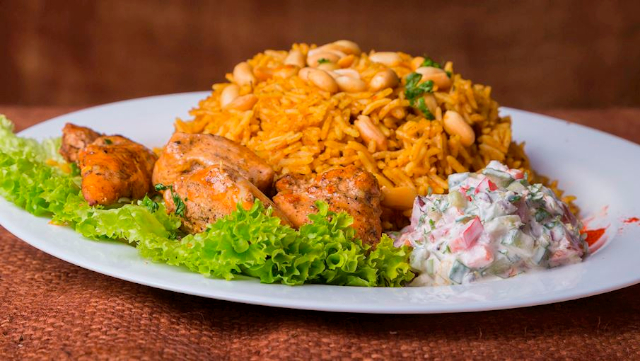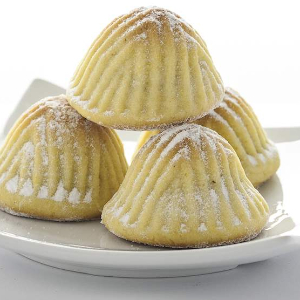So… You’ve watched a few movies where the hero walks into the tent-palace of a Saudi sheik who serves up a huge feast of roasted meats stacked on mammoth platters of savoury rice, and you think you know all about Saudi Arabian food. Think again! There’s much more to it than that…
 Kabsa: A traditional Saudi main dish, served over the stereotypical huge tray of rice.
Kabsa: A traditional Saudi main dish, served over the stereotypical huge tray of rice.
You wouldn’t be wrong to think that platter of rice and roasted meat was a staple of Saudi cuisine. It is, and has been for millennia. You’d be way wrong, though, if you thought that was the be all and end all of Saudi cuisine! Behold the cream of Saudi food mastery as selected for us and described by the folks at tasteatlas.com…
On our menu today:
Kabsa is a rice dish that is enjoyed throughout the Gulf States of the Arabian Peninsula. Heavily influenced by Persian and Indian biryanis, kabsa makes use of the water that was used to cook fish or meat, re-using it to cook the spiced, long-grain rice, perfectly blending all the flavors and spices. The dish can be made with chicken, lamb, camel meat, fish, or even shrimps. As shown in the movies, the meat or fish is usually placed on top of the rice, and the whole dish is served on a large platter, meant to be shared and eaten with the hands. Although it originated in Yemen, this traditional combination of rice and meat is incredibly popular in Saudi Arabia, where it is considered a national dish.
Saleeg is another meat and rice dish served on a big platter and shared communally. Its cooking method is as unique as is the experience of eating it.
consisting of creamy, porridge-like short-grain rice and roasted meat. Chicken is the most common meat choice, and it is typically boiled in water with spices before it is roasted. The dish uses a combination of the broth in which the meat has been cooking and hot water to boil the rice. The boiled rice is then combined with milk and ghee or butter, and cooked until it reaches the desired consistency. It looks like a cross between a creamy rice pudding and a pilaf. Serve topped with roasted meat
Up until today, I thought Shawarma was native to Lebanon and had been shared out to other Middle Eastern cuisines from there. Shawarma is definitely market-positioned that way here in my native land, but that may be that because the vast majority of the Shawarma shops are run by Lebanese immigrants. My negligence! my bad! Marinated and spit-roasted, shawarma is a delicious Middle Eastern meat treat whose origins can be traced back to the Ottoman Empire, where it got its name from the Arabic pronunciation of the Turkish word çevirme (lit. to turn; turning), referring to the rotating skewer (vertical broiler) on which the meat is cooked. Shawarmas can be made with lamb, turkey, chicken, beef, or a mix of different meats which are slow-cooked for hours and basted in their own juices and fat, gaining an incomparable succulence But the real secret to a perfect shawarma is in the marinade. Serve with rice and salad.
Harees is a one-pot main dish comprising meat, coarsely ground wheat, butter and water, and left to soak overnight. It’s popular across the Middle East and is considered a staple during the holy month of Ramadan. Like Shawarma, it’s believed that Harees originated in the Saudi Arabia and spread throughout the Middle East and India from there.
Gursan is another popular one-pot meal made mainly of meat and relying on its slow-cooking juices for its magical flavour. For this one, you simply stack thinly-sliced bread over meat and veggies, and cover which will produce a broth. The bread softens when it soaks up the juices, but the dish – when made correctly – is not soupy. More like a pudding with long-simmered meat and veggies.
Tharid is most often described as a spicy lamb stew thickened with barley bread, though the word tharīd also refers to a large earthenware bowl. According to legend and several Hadith teachings, tharīd was one of the Prophet Muhammad’s favorite dishes, even though its origins are said to date back to the pre-Islamic times. Today, this satisfying dish is prepared with a variety of halāl meats which are stewed with vegetables and ladled over thin, unleavened bread. In Islamic countries, tharīd is typically enjoyed for al’iiftar, the evening meal served at sunset when Muslims end their daily Ramadan fast.
Hininy is a traditional Saudi Arabian dish consisting of dates, butter, and brown bread. The whole concoction is then additionally flavored with spices such as saffron and cardamom. The dish is a specialty of Najd, where it is usually prepared during the winter. Not particularly, a dessert, the western palate may label it so. But that’s okay…
A true Saudi dessert is the popular Ma’amoul, an ancient cookie filled with fruits and nuts such as dates, walnuts, and pistachios. They’re traditionally prepared for Easter, festivals and celebrations, and they are typically shaped into balls or domes. In order to differentiate the cookies, the walnut version is usually shaped into a dome with a round top, and the date ma’amoul is shaped into a dome with a flat top, while the pistachio ma’amoul has an elongated, oval shape. It is not uncommon for ma’amoul to be topped with powdered sugar for extra sweetness. Serve with coffee or tea during the day.
There you have it!
Seems you can have your stereotypical giant tray of rice and eat it too!
~ Maggie J.

